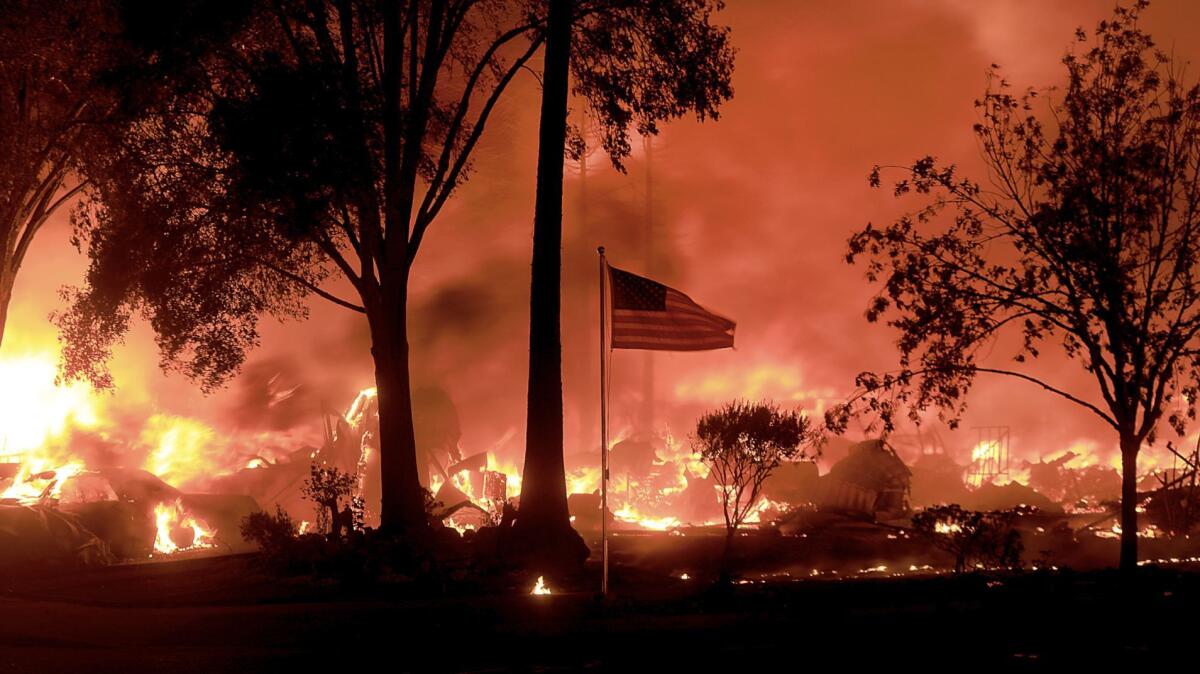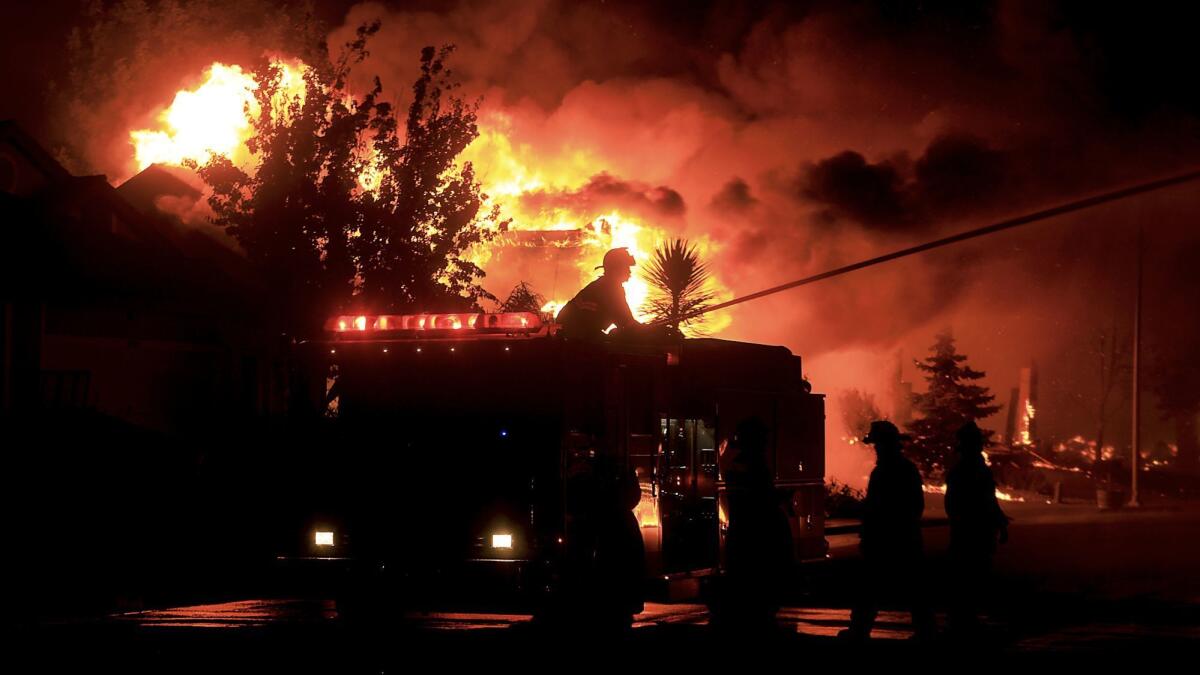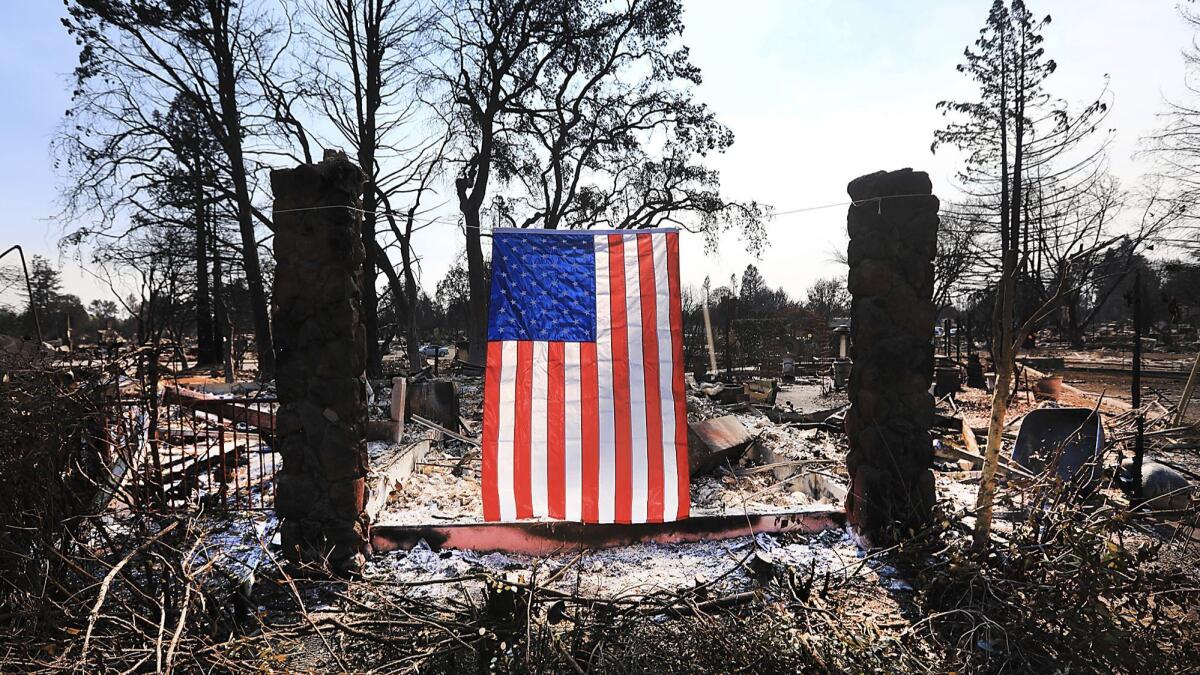As wildfires raged, a local newspaper sprang into action to document the devastation
- Share via
Trees exploded, one after another, as Kent Porter watched the glow of fire roll over a nearby hill.
Parked at Camp Newman, a summer retreat in Santa Rosa, Porter had spent the past hour on this Sunday night shooting photos of the fires that began rapidly engulfing parts of his community.
A photojournalist from Lake County, Calif., with 30 years of experience, Porter knew this fire was going to be unlike any other that he had ever covered. At precisely 11:19 p.m. on Oct. 8, he called the Press Democrat’s managing editor, Ted Appel.
“He’s very emphatic about it that this was going to be a major catastrophe for the region and that we needed to get people going,” Appel said.
Porter was the first journalist at the Press Democrat, Santa Rosa’s newspaper, to get a sense of the magnitude of the Northern California wildfires, which became the deadliest in California’s history. More than a dozen fires broke out that night. They eventually killed 42 people, destroyed more than 8,400 homes and other buildings and burned 100,000 acres in Napa and Sonoma counties.
As the blazes roared, a small team of reporters from the largest city in Sonoma County sprang to action.
Embers blew like horizontal rain as Porter continued working, often parking his car in the middle of the road and rolling down his window to get photos. As he sat in his car at the highest part of Santa Rosa’s Fountaingrove neighborhood, he could not believe what he was seeing.

“I knew a few of the people up there,” Porter said. “Almost every home was on fire. I think only two homes survived out of about 200.”
Meanwhile, reporters began making treks to the Press Democrat’s newsroom in the dead of night, even as their own families prepared to evacuate.
“There’s a number of instances where spouses went one direction toward safety and the reporter or photographer went the other direction in the flames,” Appel said.
Appel made it to the newsroom at 1 a.m., leaving his wife and teenage daughter behind. When an evacuation was ordered for his neighborhood about 3:30 a.m., Appel’s wife and daughter took their dog, packed up the car with everything they could on short notice, and headed straight to the newsroom.
Executive editor Catherine Barnett encountered a downed tree, a blocked highway exit and took back roads on her way to the office. Around 2 a.m., she drove past an evacuation center where people were being turned away.
“I grew up here,” Barnett said. “I don’t ever remember anything like this.”
In the newsroom, reporters worked frantically to begin telling the story of the raging fires. Their families — children, spouses, dogs and cats — spent the night in the office as the emergency radio scanners exploded with calls.
By sunrise, Appel said that basically all of the Press Democrat’s 51 reporters, editors, photographers and copy editors were working on the story. By then, the scale of the disaster came into focus.
“Often with disasters, you don’t really know people affected by it,” Barnett said. “Now it’s hard to find somebody you don’t know.”
Barnett says many people turned to the Press Democrat’s digital report.

“We had an unprecedented number of users who came to our website to find out what was happening,” Appel said.
For those in Santa Rosa without power or gas, hard copies of the newspaper provided vital daily reports and updates. The circulation team distributed 3,000 copies of the Press Democrat to shelters each day, and employees at the printing plant worked to keep the presses rolling while worrying about their own family and friends.
In the beginning, Porter worked 16 to 17 hours each day to document the increasing devastation of the firestorms. As he shot photos of familiar landmarks, memories rushed in: taking his son on wagon rides in the now-ruined Coffey Park and trips to the ballpark with friends whose homes were reduced to a foot and a half of ash.
Porter says that many photojournalists use their camera as a shield — to protect themselves from the inherent trauma of disasters.
“I’ve learned that pushing those emotions aside is really detrimental,” Porter said. “I don’t compartmentalize anymore, I just take it all in.”
After days of covering the fires, Porter had his own “emotional firestorm” while capturing an aerial view of Santa Rosa in a National Guard helicopter. Behind a pair of sunglasses, he quietly wept before quickly regaining his composure.
“I lost it,” he said. “It was so overwhelming.”
As the smoke began clearing last week, the thank you notes started to pour in. It was Santa Rosa’s response to a small yet determined newsroom.
Barnett has reminded reporters that “pound for pound we are doing what we need to do for our community and that we will be here after the satellite dishes pack up and go away.”
Before the fires, the Press Democrat’s circulation was 45,000 daily and 50,000 on Sundays. Now, it’s less. But something else happened, Porter said.
“It was like a whole new generation discovered there’s a newspaper in my town.”



Sign up for Essential California
The most important California stories and recommendations in your inbox every morning.
You may occasionally receive promotional content from the Los Angeles Times.








